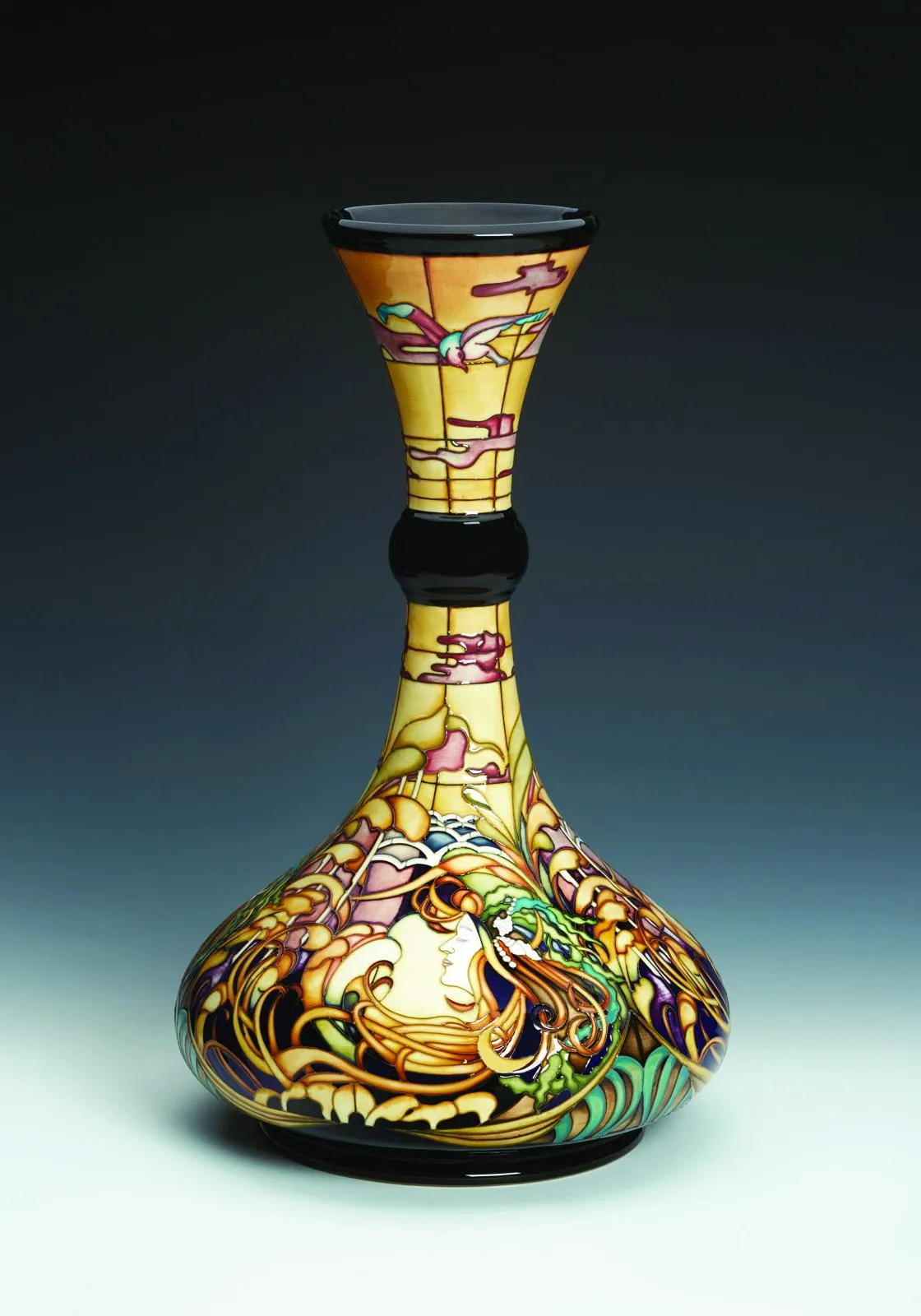'It’s my private passion and always has been,’ says ceramics expert Eric Knowles about Moorcroft, the art pottery manufactory he’s championed as non-executive director for more than two decades and admired for much longer than he cares to remember. ‘Where I grew up, people didn’t have a lot, but what they had most of was crockery. It abounded in second-hand shops, and you could buy things for very little. But Moorcroft was different. It was always held in respect. You wouldn’t throw a Moorcroft pot out because you knew it cost money. And when I became interested in Art Nouveau, it seemed leaps ahead of anything else made in this country.’
Within the history of British ceramics, Moorcroft stands out as a rare survivor. Not only does it still hand-make pots in Stoke-on-Trent as it has since the Arts and Crafts period, it’s also one of the very few potteries to have remained in independent ownership. ‘When we say Made in England we really do mean it,’ says Elise Adams, Moorcroft’s proud MD. ‘People can come and visit our original factory and see each stage of the production process.’

The factory’s founder, a Staffordshire potter named William Moorcroft, was born in 1872, and trained at what is now the Royal College of Art in London before returning to Stoke in 1897 to join the manufactory of Macintyre & Co as a designer. Young and brimming with ideas, William Moorcroft was soon installed in Macintyre’s art pottery studio, where he began by producing pieces influenced by William Morris, before developing a range that combined classical shapes with the latest Art Nouveau naturalism.
Christened ‘Florian Ware’, these pots featured tubelining; a distinctive decorative method where the design was drawn onto a pot like icing a cake, and colour applied between the lines. The technique gave a tactile quality to the pots and, to underline their status as works of art, most of the eye-catching pieces were hand- signed by Moorcroft to endorse their quality. ‘The combination of shape with inventive decoration gave them a wow factor that was picked up by fashionable people shopping at Liberty, who were looking for what was new,’ says Eric. ‘Moorcroft was all about harmony, the colours, the soft gilding. His works were tasteful, he was an arbiter of taste.’ Florian Ware also found huge success in America, where it won a gold medal at the prestigious St Louis International Exhibition in 1904.
Despite William’s boundless energy, his progress wasn’t all smooth. In 1913, after a falling out, he parted company with Macintyre. Helped by the financial backing of Liberty, and spurred on by his determination, William lost little time in founding his own factory nearby. ‘Within 18 months he had gone from idea to building a state-of-the-art factory; an extraordinary achievement. He even married the factory’s inspector, Miss Florence Lovibond,’ says Eric.

Moorcroft’s range of wares now expanded further: designs featuring flora, fauna, fungi and landscapes, delineated in trademark tubelining and painted in subtle colours, brought further accolades, and in 1928 the company achieved the great honour of a Royal Warrant.
William’s son Walter joined the company in 1935, working alongside his father until the war intervened. After William’s death in 1945, Walter returned and took over, establishing his own distinctive designs that echoed the styles of the day. When the 1980s recession hit, however, Moorcroft found itself in serious financial difficulties. Eventually, after various changes, it was saved by Hugh Edwards and Richard Dennis, whose wife, fashion designer Sally Tuffin, became the factory’s art director. It was her designs that saved the company. Some years later, Richard and Sally parted company with Moorcroft to start the Dennis China Works, leaving Edwards as chairman.
This year marks the 150th anniversary of William Moorcroft’s birth and the factory’s designers are hard at work on a tribute collection. ‘Taking inspiration from William’s creations, they have come up with their own designs, and the plan is to launch them in March,’ says Elise. Like all Moorcroft pots, the new range will adhere to the traditional techniques that William would recognise. ‘Visitors to the Heritage Centre can compare modern pieces with William’s originals, many of which are on display in the Moorcroft Museum,’ says Elise. ‘They can also see the bottle oven where pieces were originally fired. There were once around 2,000 to 3,000 of these in this area. Now only 47 are left.’
Moorcroft’s limited, high-quality output has long made it attractive to collectors. ‘We can only produce so many pieces a year. We have a small team of tubeliners and painters, so we might make just five pieces of a design, but that means they are very sought after and collectable,’ says Elise. ‘It’s part of our appeal, and we cut our own path, selling mainly in specialist shops and at events such as the Chelsea and Hampton Court flower shows.’
Prices for modern pieces range from about £70 to £5,000, depending on the size, and how long it takes to make a piece. ‘Some pieces take us three to four weeks from coming out of the mould to emerging from the kiln and completing their journey,’ says Elise. On the antiques market, Moorcroft has dipped a little in value in recent years, but prices start at £50 and rare pieces still command thousands.
New designs are supervised by Elise, who briefs the team if there are special commissions and encourages them to present their own ideas. ‘No two days are ever the same. I’ve been here 24 years now and design is constantly evolving. There’s always something to look forward to. We’re creating new art every day; there’s nothing better, and the firm still has a family ethos. That’s a lovely thing in the 21st century.’










